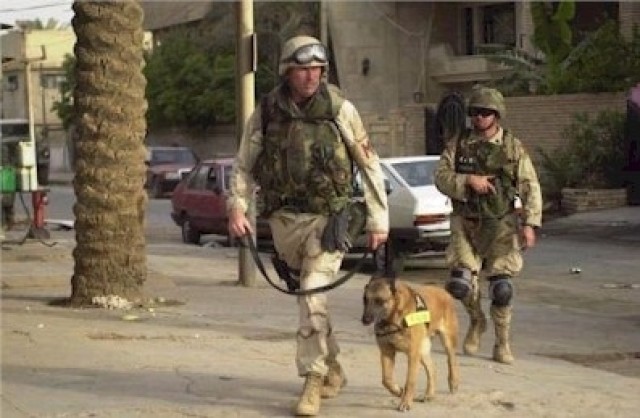WASHINGTON (Army News Service, Feb. 2, 2007) - Some Army "heroes" serving with Soldiers in the war on terror seldom get mentioned in the media, although they, too, have died in combat while serving America. They are military working dogs, and during the Vietnam War 281 of these four-footed heroes died in action.
<i>(For the Army's response to recently surfacing video footage showing three Soldiers behaving inappropriately toward an injured dog in Iraq, click <a href="http://www.army.mil/-news/2007/02/02/1638-response-to-inappropriate-behavior-toward-injured-dog/index.html"target=_blank> here</a>.)</i>
One such dog recently returned home to Fort Belvoir, Va., from a tour of duty in Iraq, where she spent six months detecting explosives. Vendi, a 4-year-old German shepherd, is one of many unsung heroes, military working dogs who work alongside U.S. servicemembers.
Of about 500 MWDs currently detailed to the Army, many are working with Soldiers in Iraq, said Sgt. 1st Class Donald Nelson, Fort Belvoir's K-9 kennel master. Deployed dogs can spend up to a year in the war zone and will eventually return to their home posts to resume duties as patrol dogs, specializing in narcotics or explosives detection.
Nelson and his team of 10 dogs and their handlers make up the Fort Belvoir Police Canine Unit, and Nelson anticipates getting four more dogs.
"These dogs are our partners, not our pets," Nelson said. And while they can be their handler's best friend, they can be a foe's worst enemy. When their aggression level is high and they're looking for something to bite, that's when they become "war dogs," and they can be as intimidating and formidable as any armed Soldier. The average German shepherd's bite can exert up to 1,200 pounds of pressure per square inch, Nelson said.
Seven-year-old Arrow, a German shepherd and Belgian malinois mix, has an impressive record, Nelson said. Arrow assisted the U.S. Secret Service in about 50 missions, including providing security at the 2004 Democratic and Republican national conventions. Arrow and Nelson, his handler at the time, also helped provide security for President Bush and John Kerry on the 2004 campaign trail.
Fort Belvoir's team of German shepherds and Belgian malinois are dual-certified as either patrol-narcotics or patrol-explosives dogs, and are trained to detect a variety of explosives or narcotics. When commanded to search, the dogs are extremely focused and obsessively search for contraband, obeying the handler's precise one-word commands they were taught in training.
The dog teams are held to high standards and are subject to monthly proficiency tests and quarterly validations, Nelson said.
German shepherds and Belgian malinois are specifically chosen for the type of work they do because of their endurance, speed, strength, courage, intelligence and adaptability to almost any climate, Nelson said. Though their hearing is better than that of humans, their keenest sense is of smell.
"The dogs smell the way we humans see. They can smell an infinite number of different scents in an area, just as we see many different images at once, in one place," Nelson said.
Two-year-old Tarak, the newest German shepherd at the Belvoir kennel, arrived in March from Lackland Air Force Base, Texas, where all MWDs are trained. Tarak graduated from a 120-day training course that teaches MWDs a variety of aggression techniques, including methods of attack. The first phase of training involves searching buildings and scouting for "bad guys." The second phase is detection training.
The primary function of a patrol dog team is to utilize the dog's keen senses of hearing and smell to conduct walking patrols around buildings and open areas, "for people who try to elude police," said Nelson.
Patrol dogs are trained to remain alert but calm with unfamiliar people, and to discriminate between threatening and nonthreatening people. The dogs are trained to attack as well as instantly stop the attack when given the command to do so.
Nelson said the Army has the strictest policy concerning the training of MWDs. They undergo at least 16 hours' training monthly, in both detection and patrolling. In narcotics detection the dogs must maintain 90-percent proficiency, and in explosives detection must achieve at least a 95-percent proficiency, Nelson said.
The staff at the Lackland Training Detachment, 701st Military Police Battalion, trains all MWDs in explosives or narcotics detection. The program also teaches the dog basic obedience, as well as more advanced skills, such as how to attack and how to sniff out specific substances.
Once the dogs receive their initial training, they and their trainers work as a team. The dog has skills to learn, and the handler has to learn to recognize what the dog is trying to communicate, Nelson said.
Each handler is assigned to one dog and is charged with building a strong rapport with that dog. This results in an effective and trusting team. Handlers are responsible for the feeding, grooming, training and exercising of their assigned partners.
Army regulations dictate that handlers and their MWDs have 45 to 90 days to become certified in narcotics or explosives detection once the team is given its assignment.
While training their dogs, handlers must be patient or the dog will become confused and hard to handle, Nelson said. When a dog performs a desired task, he's rewarded with verbal or physical praise and positive reinforcement. Likewise, with incorrect responses, praise and reward are withheld. Positive training is the key to training dogs to obey, Nelson said.




Social Sharing